Itamar Friedman
Code Generation with AlphaCodium: From Prompt Engineering to Flow Engineering
Jan 16, 2024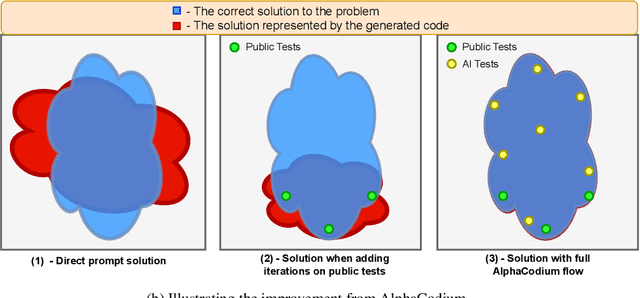
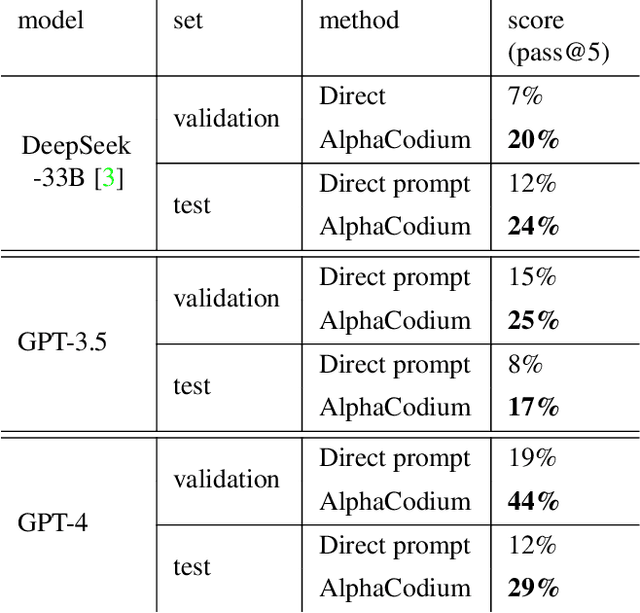
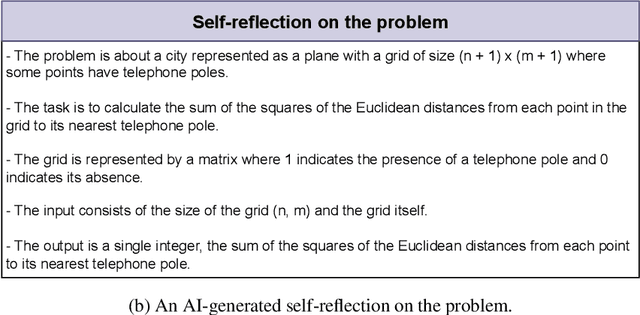
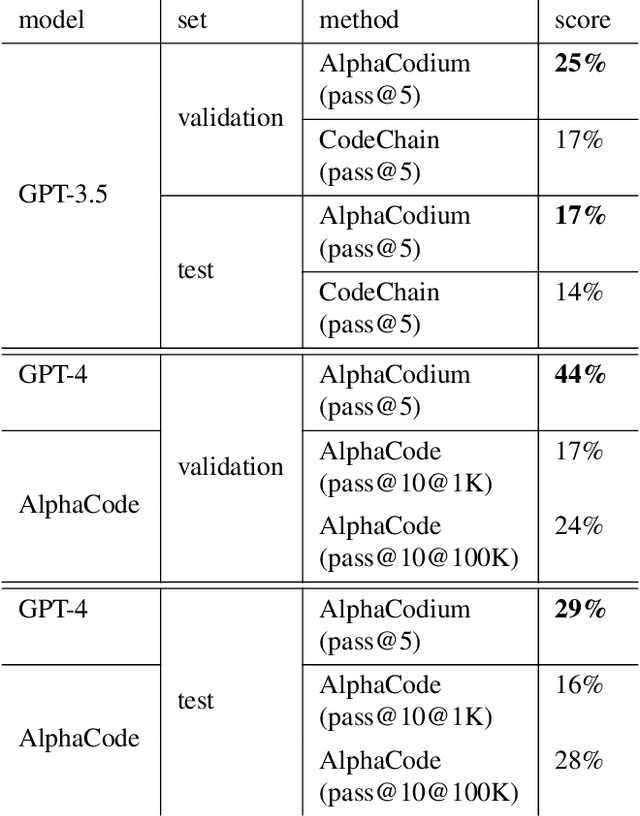
Abstract:Code generation problems differ from common natural language problems - they require matching the exact syntax of the target language, identifying happy paths and edge cases, paying attention to numerous small details in the problem spec, and addressing other code-specific issues and requirements. Hence, many of the optimizations and tricks that have been successful in natural language generation may not be effective for code tasks. In this work, we propose a new approach to code generation by LLMs, which we call AlphaCodium - a test-based, multi-stage, code-oriented iterative flow, that improves the performances of LLMs on code problems. We tested AlphaCodium on a challenging code generation dataset called CodeContests, which includes competitive programming problems from platforms such as Codeforces. The proposed flow consistently and significantly improves results. On the validation set, for example, GPT-4 accuracy (pass@5) increased from 19% with a single well-designed direct prompt to 44% with the AlphaCodium flow. Many of the principles and best practices acquired in this work, we believe, are broadly applicable to general code generation tasks. Full implementation is available at: https://github.com/Codium-ai/AlphaCodium
Multi-label Classification with Partial Annotations using Class-aware Selective Loss
Oct 21, 2021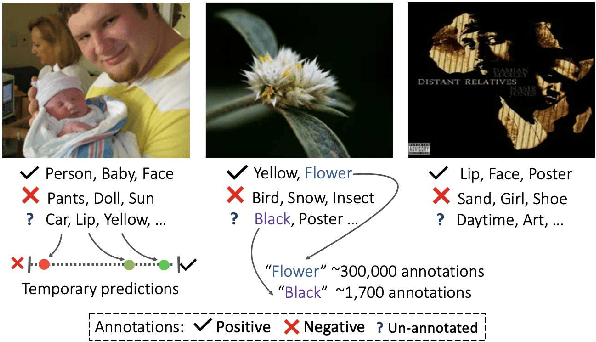
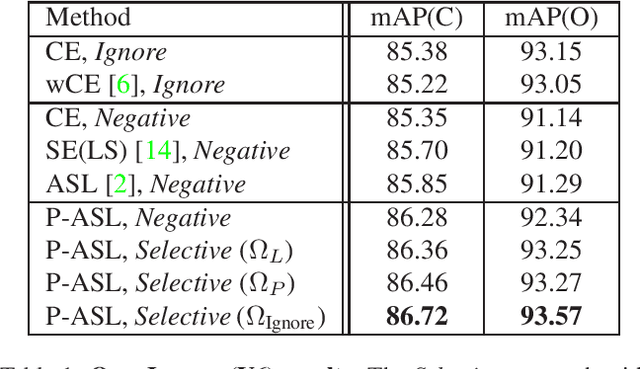

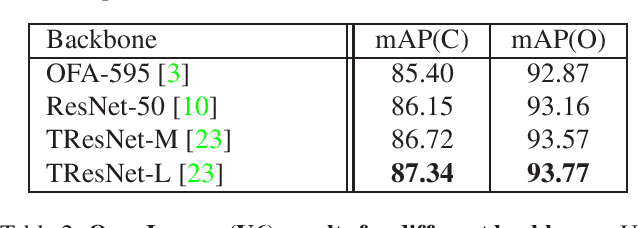
Abstract:Large-scale multi-label classification datasets are commonly, and perhaps inevitably, partially annotated. That is, only a small subset of labels are annotated per sample. Different methods for handling the missing labels induce different properties on the model and impact its accuracy. In this work, we analyze the partial labeling problem, then propose a solution based on two key ideas. First, un-annotated labels should be treated selectively according to two probability quantities: the class distribution in the overall dataset and the specific label likelihood for a given data sample. We propose to estimate the class distribution using a dedicated temporary model, and we show its improved efficiency over a naive estimation computed using the dataset's partial annotations. Second, during the training of the target model, we emphasize the contribution of annotated labels over originally un-annotated labels by using a dedicated asymmetric loss. With our novel approach, we achieve state-of-the-art results on OpenImages dataset (e.g. reaching 87.3 mAP on V6). In addition, experiments conducted on LVIS and simulated-COCO demonstrate the effectiveness of our approach. Code is available at https://github.com/Alibaba-MIIL/PartialLabelingCSL.
Semantic Diversity Learning for Zero-Shot Multi-label Classification
May 12, 2021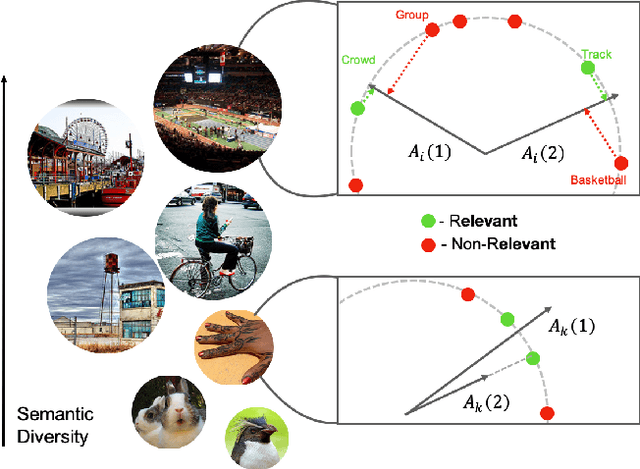
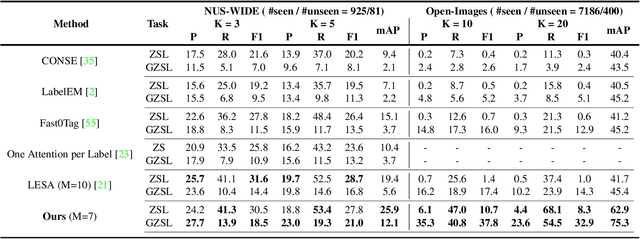

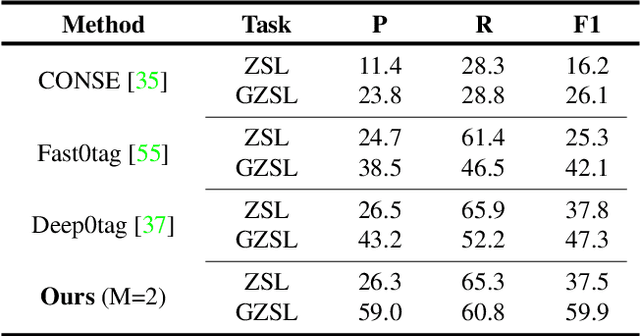
Abstract:Training a neural network model for recognizing multiple labels associated with an image, including identifying unseen labels, is challenging, especially for images that portray numerous semantically diverse labels. As challenging as this task is, it is an essential task to tackle since it represents many real-world cases, such as image retrieval of natural images. We argue that using a single embedding vector to represent an image, as commonly practiced, is not sufficient to rank both relevant seen and unseen labels accurately. This study introduces an end-to-end model training for multi-label zero-shot learning that supports semantic diversity of the images and labels. We propose to use an embedding matrix having principal embedding vectors trained using a tailored loss function. In addition, during training, we suggest up-weighting in the loss function image samples presenting higher semantic diversity to encourage the diversity of the embedding matrix. Extensive experiments show that our proposed method improves the zero-shot model's quality in tag-based image retrieval achieving SoTA results on several common datasets (NUS-Wide, COCO, Open Images).
Asymmetric Loss For Multi-Label Classification
Sep 29, 2020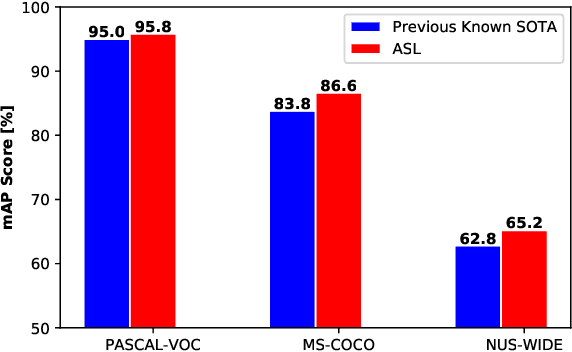
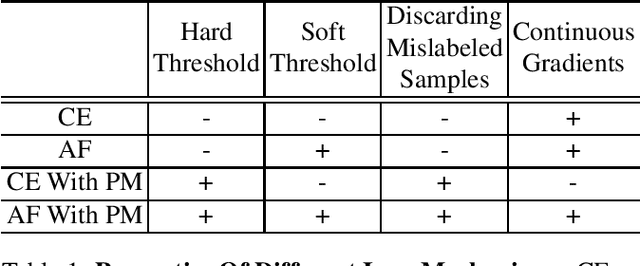
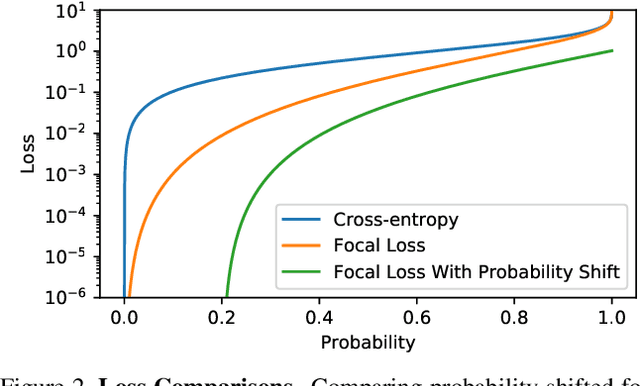

Abstract:Pictures of everyday life are inherently multi-label in nature. Hence, multi-label classification is commonly used to analyze their content. In typical multi-label datasets, each picture contains only a few positive labels, and many negative ones. This positive-negative imbalance can result in under-emphasizing gradients from positive labels during training, leading to poor accuracy. In this paper, we introduce a novel asymmetric loss ("ASL"), that operates differently on positive and negative samples. The loss dynamically down-weights the importance of easy negative samples, causing the optimization process to focus more on the positive samples, and also enables to discard mislabeled negative samples. We demonstrate how ASL leads to a more "balanced" network, with increased average probabilities for positive samples, and show how this balanced network is translated to better mAP scores, compared to commonly used losses. Furthermore, we offer a method that can dynamically adjust the level of asymmetry throughout the training. With ASL, we reach new state-of-the-art results on three common multi-label datasets, including achieving 86.6% on MS-COCO. We also demonstrate ASL applicability for other tasks such as fine-grain single-label classification and object detection. ASL is effective, easy to implement, and does not increase the training time or complexity. Implementation is available at: https://github.com/Alibaba-MIIL/ASL.
TResNet: High Performance GPU-Dedicated Architecture
Mar 30, 2020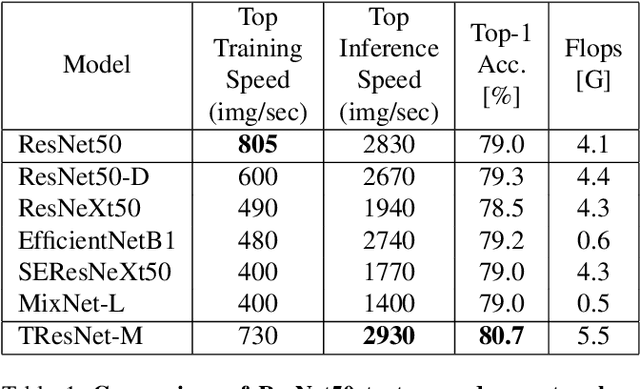



Abstract:Many deep learning models, developed in recent years, reach higher ImageNet accuracy than ResNet50, with fewer or comparable FLOPS count. While FLOPs are often seen as a proxy for network efficiency, when measuring actual GPU training and inference throughput, vanilla ResNet50 is usually significantly faster than its recent competitors, offering better throughput-accuracy trade-off. In this work, we introduce a series of architecture modifications that aim to boost neural networks' accuracy, while retaining their GPU training and inference efficiency. We first demonstrate and discuss the bottlenecks induced by FLOPs-optimizations. We then suggest alternative designs that better utilize GPU structure and assets. Finally, we introduce a new family of GPU-dedicated models, called TResNet, which achieve better accuracy and efficiency than previous ConvNets. Using a TResNet model, with similar GPU throughput to ResNet50, we reach 80.7% top-1 accuracy on ImageNet. Our TResNet models also transfer well and achieve state-of-the-art accuracy on competitive datasets such as Stanford cars (96.0%), CIFAR-10 (99.0%), CIFAR-100 (91.5%) and Oxford-Flowers (99.1%). Implementation is available at: https://github.com/mrT23/TResNet
Knapsack Pruning with Inner Distillation
Feb 21, 2020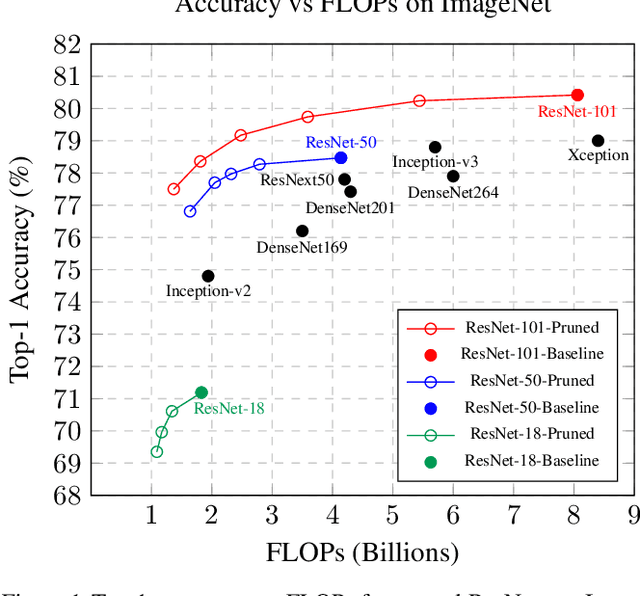
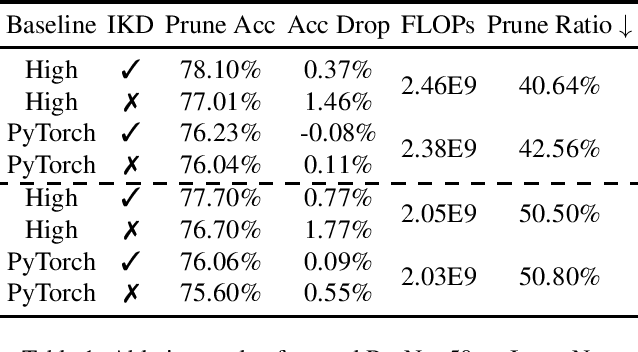

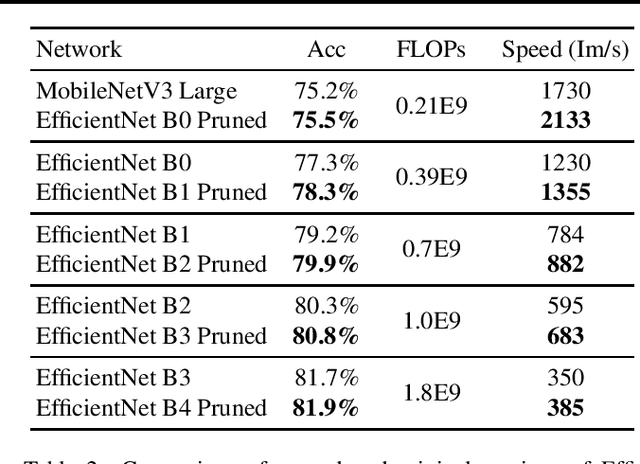
Abstract:Neural network pruning reduces the computational cost of an over-parameterized network to improve its efficiency. Popular methods vary from $\ell_1$-norm sparsification to Neural Architecture Search (NAS). In this work, we propose a novel pruning method that optimizes the final accuracy of the pruned network and distills knowledge from the over-parameterized parent network's inner layers. To enable this approach, we formulate the network pruning as a Knapsack Problem which optimizes the trade-off between the importance of neurons and their associated computational cost. Then we prune the network channels while maintaining the high-level structure of the network. The pruned network is fine-tuned under the supervision of the parent network using its inner network knowledge, a technique we refer to as the Inner Knowledge Distillation. Our method leads to state-of-the-art pruning results on ImageNet, CIFAR-10 and CIFAR-100 using ResNet backbones. To prune complex network structures such as convolutions with skip-links and depth-wise convolutions, we propose a block grouping approach to cope with these structures. Through this we produce compact architectures with the same FLOPs as EfficientNet-B0 and MobileNetV3 but with higher accuracy, by $1\%$ and $0.3\%$ respectively on ImageNet, and faster runtime on GPU.
Graph Embedded Pose Clustering for Anomaly Detection
Dec 26, 2019
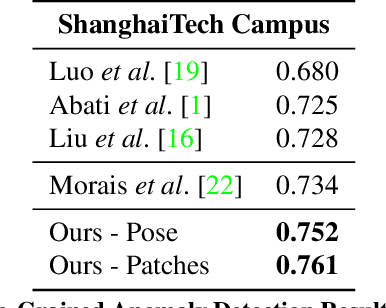


Abstract:We propose a new method for anomaly detection of human actions. Our method works directly on human pose graphs that can be computed from an input video sequence. This makes the analysis independent of nuisance parameters such as viewpoint or illumination. We map these graphs to a latent space and cluster them. Each action is then represented by its soft-assignment to each of the clusters. This gives a kind of "bag of words" representation to the data, where every action is represented by its similarity to a group of base action-words. Then, we use a Dirichlet process based mixture, that is useful for handling proportional data such as our soft-assignment vectors, to determine if an action is normal or not. We evaluate our method on two types of data sets. The first is a fine-grained anomaly detection data set (e.g. ShanghaiTech) where we wish to detect unusual variations of some action. The second is a coarse-grained anomaly detection data set (e.g.,\ a Kinetics-based data set) where few actions are considered normal, and every other action should be considered abnormal. Extensive experiments on the benchmarks show that our method performs considerably better than other state of the art methods.
Attention Network Robustification for Person ReID
Oct 29, 2019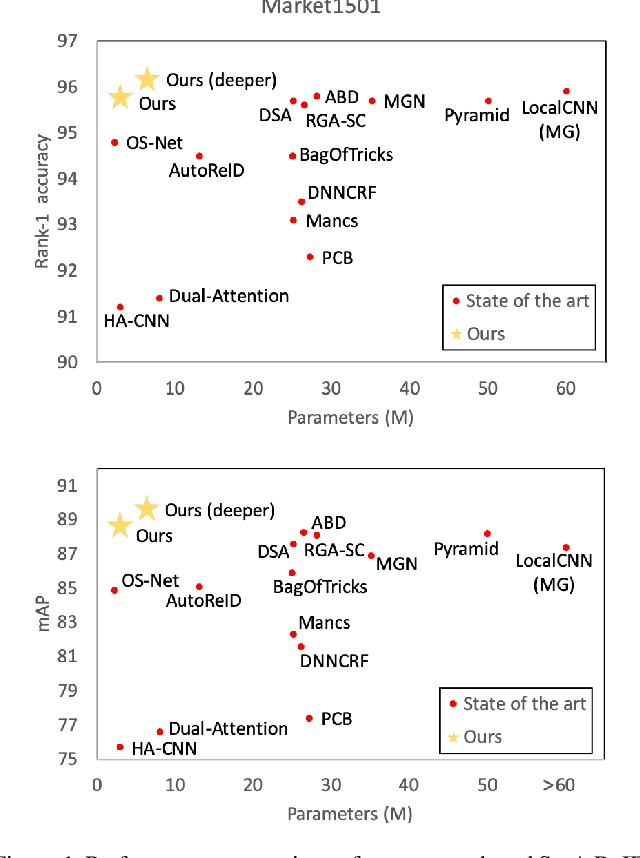
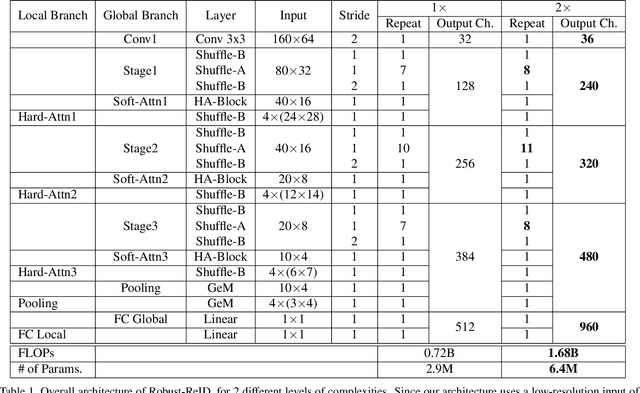
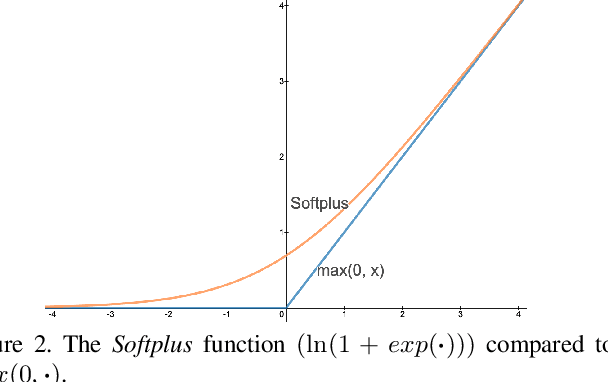

Abstract:The task of person re-identification (ReID) has attracted growing attention in recent years with improving performance but lack of focus on real-world applications. Most state of the art methods use large pre-trained models, e.g., ResNet50 (~25M parameters), as their backbone, which makes it tedious to explore different architecture modifications. In this study, we focus on small-sized randomly initialized models which enable us to easily introduce network and training modifications suitable for person ReID public datasets and real-world setups. We show the robustness of our network and training improvements by outperforming state of the art results in terms of rank-1 accuracy and mAP on Market1501 (96.2, 89.7) and DukeMTMC (89.8, 80.3) with only 6.4M parameters and without using re-ranking. Finally, we show the applicability of the proposed ReID network for multi-object tracking.
XNAS: Neural Architecture Search with Expert Advice
Jun 19, 2019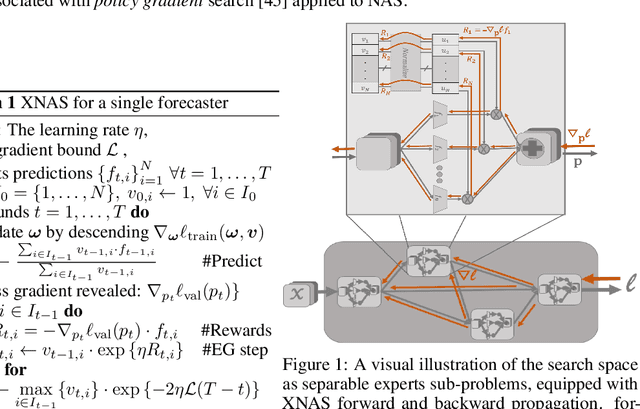
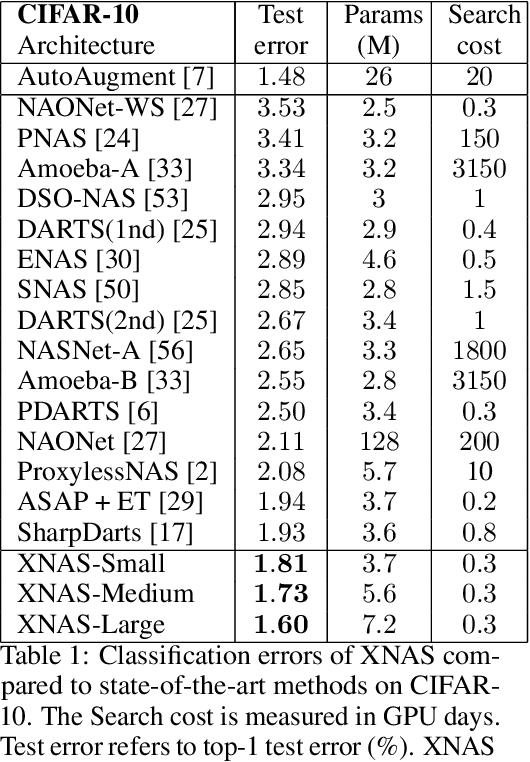
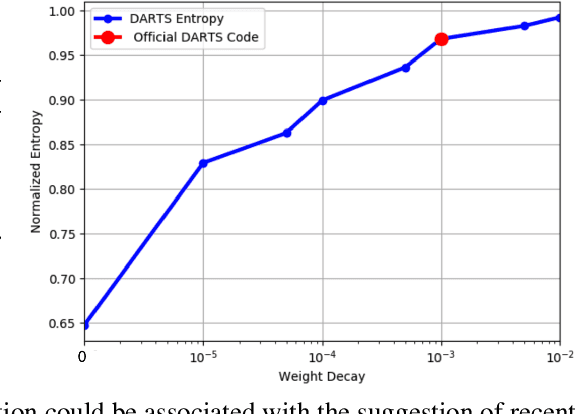
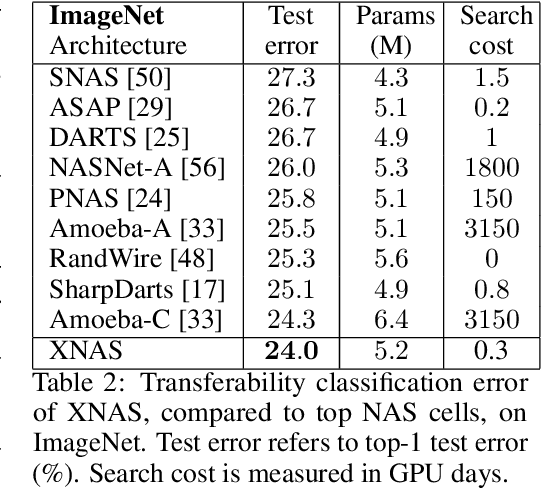
Abstract:This paper introduces a novel optimization method for differential neural architecture search, based on the theory of prediction with expert advice. Its optimization criterion is well fitted for an architecture-selection, i.e., it minimizes the regret incurred by a sub-optimal selection of operations. Unlike previous search relaxations, that require hard pruning of architectures, our method is designed to dynamically wipe out inferior architectures and enhance superior ones. It achieves an optimal worst-case regret bound and suggests the use of multiple learning-rates, based on the amount of information carried by the backward gradients. Experiments show that our algorithm achieves a strong performance over several image classification datasets. Specifically, it obtains an error rate of 1.6% for CIFAR-10, 24% for ImageNet under mobile settings, and achieves state-of-the-art results on three additional datasets.
ASAP: Architecture Search, Anneal and Prune
Apr 08, 2019
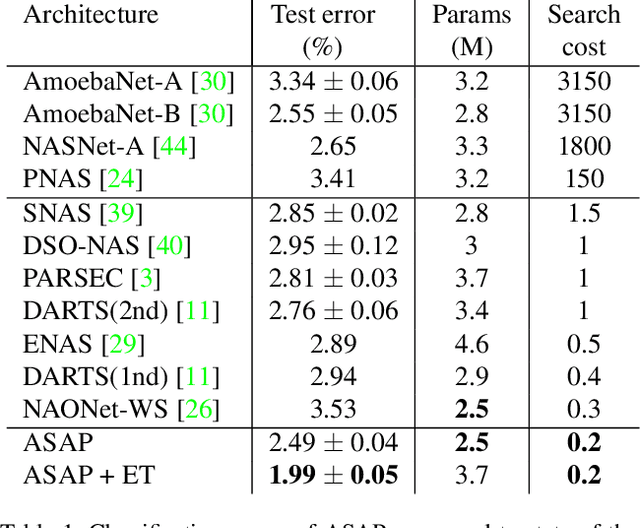
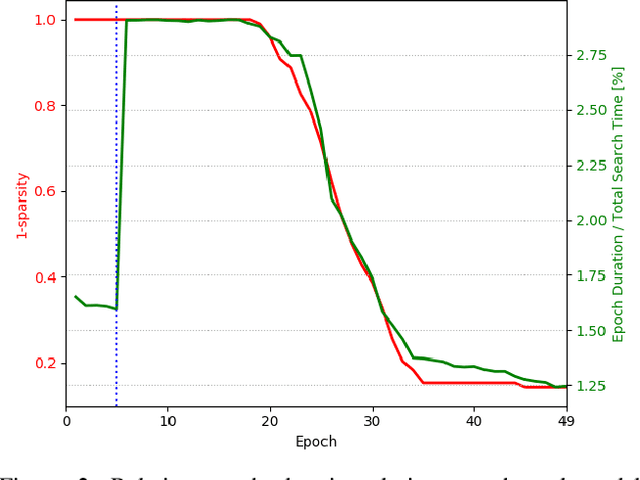

Abstract:Automatic methods for Neural Architecture Search (NAS) have been shown to produce state-of-the-art network models, yet, their main drawback is the computational complexity of the search process. As some primal methods optimized over a discrete search space, thousands of days of GPU were required for convergence. A recent approach is based on constructing a differentiable search space that enables gradient-based optimization, thus reducing the search time to a few days. While successful, such methods still include some incontinuous steps, e.g., the pruning of many weak connections at once. In this paper, we propose a differentiable search space that allows the annealing of architecture weights, while gradually pruning inferior operations, thus the search converges to a single output network in a continuous manner. Experiments on several vision datasets demonstrate the effectiveness of our method with respect to the search cost, accuracy and the memory footprint of the achieved model.
 Add to Chrome
Add to Chrome Add to Firefox
Add to Firefox Add to Edge
Add to Edge